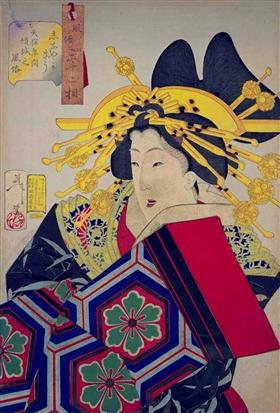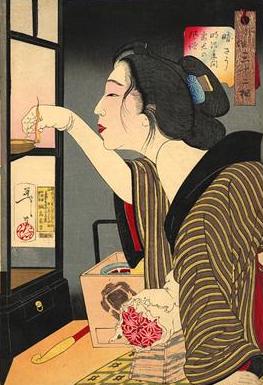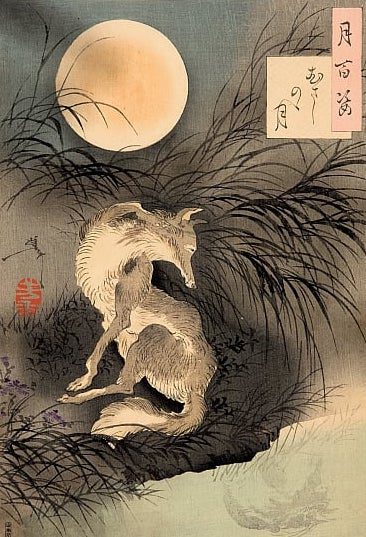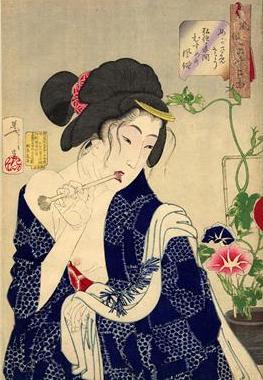Japanese art and the fading dawn of ukiyo-e
Lee Jay Walker
Modern Tokyo Times

The Meiji Restoration (1868-1912) witnessed the fading dawn of ukiyo-e – to a connection with ukiyo-e during the Taisho Period (1912-1926) called shin-hanga (new prints). However, the impact of modernization during the Meiji Period – to political and artistic elites focusing on various Western art forms – entailed that ukiyo-e would gradually become reduced to the fringes of art.
Ukiyo-e notably flourished between the late seventeenth century to the late nineteenth century before modernization took hold during the Meiji period. Despite this, many amazing ukiyo-e artists who overlapped the late Edo Period to the early Meiji Period continued to battle against the changing artistic sands that altered the art scene dramatically in Japan.

Potent Meiji era ukiyo-e artists include Ginko Adachi, Chikanobu, Kobayashi Kiyochika, Toyohara Kunichika, Kawanabe Kyosai, Mizuno Toshikata, Utagawa Yoshifuji, Yoshitoshi, and several others. Interestingly, Western artists including Pierre Bonnard, Mary Cassatt, Edgar Degas, Paul Gauguin, Toulouse-Lautrec, Claude Monet, Camille Pissarro, Pierre-Auguste Renoir, James Abbot McNeill Whistler, and Vincent Van Gogh were influenced to various degrees by ukiyo-e.
Vincent Van Gogh wrote to his brother, “My studio’s quite tolerable, mainly because I’ve pinned a set of Japanese prints on the walls that I find very diverting. You know, those little female figures in gardens or on the shore, horsemen, flowers, gnarled thorn branches.”

The artist Tsukioka Yoshitoshi (all art pieces in this article by Yoshitoshi) lived between 1839-1892. Many individuals deem Yoshitoshi to be the last great master of ukiyo-e. Hence, he witnessed the gradual demise of ukiyo-e.
Initially, Yoshitoshi was very open to the modernization of the Meiji Period and how internal art movements would develop. Yet, with each passing year, Yoshitoshi’s openness gradually turned to fear because political elites were focused on replacing internal artistic and cultural traits.

Kobayashi Kiyochika (1847-1915) – similar to Yoshitoshi – also battled against the shifting artistic sands. Hence, while Yoshitoshi is deemed the last great master of ukiyo-e, Kiyochika is deemed the last significant artist of this art form. Therefore, the fading dawn of ukiyo-e ultimately died with the death of Kiyochika.
The shin-hanga art movement during the Taisho and early Showa period kept the flag going to a lesser degree by connecting with the richness of ukiyo-e. However, the shin-hanga subject matter was limited in comparison to ukiyo-e. Therefore, the sun was firmly set concerning the marginalization of ukiyo-e within modern Japan -outside of the pulling power of this art movement drawing in crowds to view Edo and Meiji ukiyo-e art in museums today.

PLEASE DONATE TO HELP MODERN TOKYO TIMES
Modern Tokyo News is part of the Modern Tokyo Times group
DONATIONS to SUPPORT MODERN TOKYO TIMES – please pay PayPal and DONATE to sawakoart@gmail.com
http://moderntokyotimes.com Modern Tokyo Times – International News and Japan News
http://sawakoart.com – Sawako Utsumi personal website and Modern Tokyo Times artist
https://moderntokyonews.com Modern Tokyo News – Tokyo News and International News
PLEASE JOIN ON TWITTER
https://twitter.com/MTT_News Modern Tokyo Times
PLEASE JOIN ON FACEBOOK
http://facebook.com/moderntokyotimes